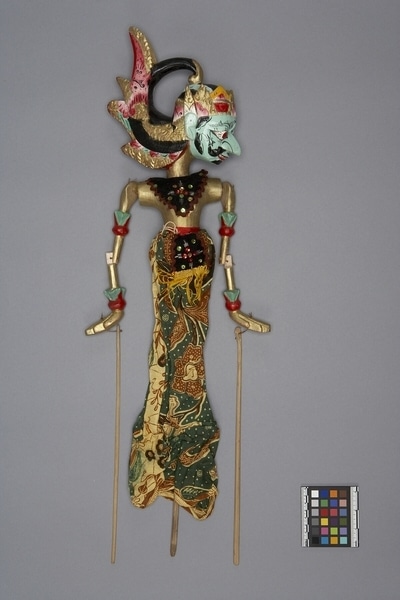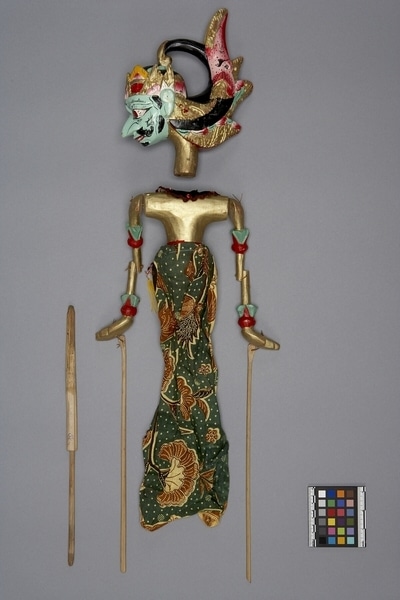Rod Puppet Item Number: Ib384 a-c from the MOA: University of British Columbia


Description
Three-dimensional male humanoid puppet: large head (part b) fits into body with skirt (part a), and a control rod (part c) with a long shaft that passes through the body and fits into the neck of the figure's head. The body has jointed arms, each with a long controlling rod attached. Green face with wedge shaped nose, bulging white eyes with red irises, red lips, exposed white teeth. Black moustache, hair, sideburns, beard, facial details. Black upswept curl headdress (gelung supit urang) with gold, red, and yellow diadem with long sumping and very wide Tali Garuda. Two large badong with red and green dawala extending from Tali. Garuda Mungkur extends high above curl, coloured red with gold siyung jawi. Gold neck and upper torso; each arm has red and green ornaments at wrist and bicep. Hands held flat and bent back at wrist. Black chest covering and apron with brown wavy trim, cross shaped pattern in sequins and beads (red and green). Apron has red waistband, long yellow fringe at bottom. Long batik skirt in beige, brown, and green.
History Of Use
Javanese puppetry as an art form probably developed by the 11th century. Wayang golek puppets of western Java appeared during the 16th century. Originally the plays depicted Javanese mythology, but after the Indian conquest of Java the Hindu epics, Ramayana and Mahabharata, were incorporated into the cycles, which comprise about 200 plays. A dalang (puppet master) performs the plays to celebrate important occasions, usually in three acts, with vocal and instrumental accompaniment. Typically they serve a moral and religious purpose, and more recently, one of political commentary. Gatot Kaca is the son of Bima, known for his courage and ability to fly. His character is very traditional. He is found in the Mahabharata cycle.
Iconographic Meaning
Each puppet is characterized by its wanda, a Javanese word which describes the specific mixture of elements of size, form, colour, ornamentation and carving. Significance of green face unclear; possibly representing spiritual maturity. Red irises suggest aggressiveness. Large facial features and hair are not refined. Position of hands, batik skirt, presence of Garuda, and elaborate clothing indicate rank or nobility (also arm ornaments). Face and headdress (particularly large badong) identify character as Gatot Kaca.
Cultural Context
Theatrical performance.
Item History
- Made in Java, Indonesia
- Owned by Donald Bone before January 4, 1980
- Received from Donald Bone (Seller) and Museum of Anthropology Donations Fund (Funding source) on January 4, 1980
What
- Name
- Rod Puppet
- Identification Number
- Ib384 a-c
- Type of Item
- puppet
- Material
- wood, cotton fibre, fibre and paint
- Manufacturing Technique
- carved, painted, tied, woven and sewn
- Part A
- height 54.0 cm, width 19.5 cm, depth 7.0 cm
- Part B
- height 24.0 cm, width 8.5 cm, depth 20.5 cm
- Part C
- height 36.0 cm, width 1.5 cm, depth 1.0 cm
Who
- Culture
- Sundanese
- Previous Owner
- Donald Bone
- Received from
- Donald Bone (Seller) and Museum of Anthropology Donations Fund (Funding source)
Where
- Holding Institution
- MOA: University of British Columbia
- Made in
- Java, Indonesia
When
- Ownership Date
- before January 4, 1980
- Acquisition Date
- on January 4, 1980
Other
- Condition
- fair
- Accession Number
- 0586/0003 a-c